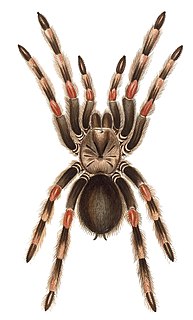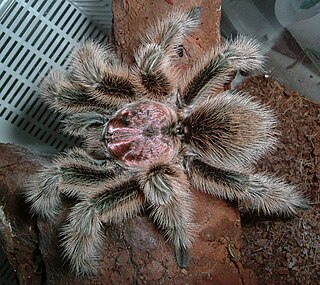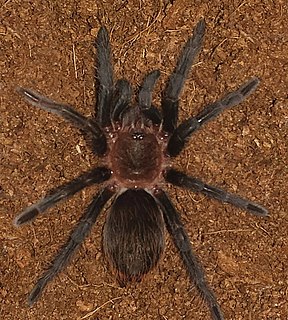
Brachypelma is a genus of spiders in the family Theraphosidae (tarantulas). They may have bodies up to 6 cm long with legs of similar or greater lengths. Some species have brightly colored legs, with red or orange marks and rings.

The Brazilian whiteknee tarantula is a species of tarantula from Brazil that is commonly kept as a pet.

Brachypelma smithi is a species of spider in the family Theraphosidae (tarantulas) native to Mexico. It has been confused with Brachypelma hamorii; both have been called Mexican redknee tarantulas. Mexican redknee tarantulas are a popular choice as pets among tarantula keepers. Many earlier sources referring to B. smithi either relate to B. hamorii or do not distinguish between the two species. B. smithi is a terrestrial tarantula native to Pacific coast of the Mexican state of Guerrero.

Grammostola is a genus of South American tarantulas that was first described by Eugène Louis Simon in 1892. These medium- to large-sized spiders are native to tropical South America, and are usually brown in color, with pinkish or orangish-red hairs. The very docile Chilean rose tarantulas are popular as a beginner's spider among tarantula enthusiasts.

Diplura is a genus of South American curtain web spiders that was first described by C. L. Koch in 1850. It is found in South America and Cuba belonging to the subfamily Diplurinae. They possess a lyra on their prolateral maxillae. Diplura species can be distinguished from Trechona sp. by the number of setae on this lyra. They differ from Harmonicon sp. by the leg formula and the shape of the lyra bristles.

Tarantulas comprise a group of large and often hairy spiders of the family Theraphosidae. Currently, 1,010 species have been identified. The term "tarantula" is usually used to describe members of the family Theraphosidae, although many other members of the same infraorder (Mygalomorphae) are commonly referred to as "tarantulas" or "false tarantulas". Some of the more common species have become popular in the exotic pet trade. Many New World species kept as pets have setae known as urticating hairs that can cause irritation to the skin, and in extreme cases, cause damage to the eyes.

The Mexican redleg or red-legged tarantula is a species of terrestrial tarantula closely related to the famous Mexican redknee tarantula. Like the redknee it is a docile tarantula and popular in the pet trade. It is slow growing and, like many tarantulas, females can live for decades.

The skeleton tarantula, Ephebopus murinus, is a species of spider belonging to the family Theraphosidae (tarantulas), sub-family Aviculariinae. A New World species, it is native to several South American countries. Its common name is derived from the skeleton-like markings on its legs.

Brachypelma albiceps is a species of spider in the tarantula family, Theraphosidae. It is known as the Mexican golden red rump tarantula or the Amula red rump tarantula. The carapace is a light golden color and the abdomen dark, covered with long red hairs. Females typically live for about 15 years. Males usually live about 5 years or up to 12 months after the last molt.

Acanthoscurria is a genus of tarantulas that was first described by Anton Ausserer in 1871.

Sericopelma is a genus of tarantula, found in Central America from Nicaragua to Panama. The limits of the genus and its distribution have long been confused; it is closely related to the genus Aphonopelma. Sericopelma species are among the largest found in Central America. They can be kept as pets, although at least one species has been described as "very aggressive".
Anisaspoides is a monotypic genus of Brazilian baldlegged spiders containing the single species, Anisaspoides gigantea. It was first described by Frederick Octavius Pickard-Cambridge in 1896, and is only found in Brazil.

Avicularia variegata is a species of spider in the family Theraphosidae found in Venezuela and Brazil. Previously described as Avicularia avicularia variegata, it is synonymous with Avicularia bicegoi.

Tliltocatl epicureanus is a species of spider in the family Theraphosidae (tarantulas), found in the Yucatán Peninsula of Mexico.
Sandinista lanceolatum is a species of spider in the family Theraphosidae (tarantulas), native to Nicaragua and Costa Rica.

Tliltocatl sabulosus is a species of spider in the family Theraphosidae (tarantulas), found in Guatemala.

Tliltocatl schroederi is a species of spiders in the family Theraphosidae (tarantulas), found in Mexico. It is found in the central valley in Oaxaca State, Mexico.

Tliltocatl verdezi is a species of spiders in the family Theraphosidae (tarantulas), found in Mexico.

Harmonicon is a genus of South American curtain web spiders that was first described by F. O. Pickard-Cambridge in 1896.

Tliltocatl is a genus of spiders in the tarantula family Theraphosidae. It was split off from Brachypelma in 2020. Species in Tliltocatl are found predominantly in Mexico, with some species native to Central America. They are large burrowing tarantulas, without the striking red leg markings of Brachypelma species.

















